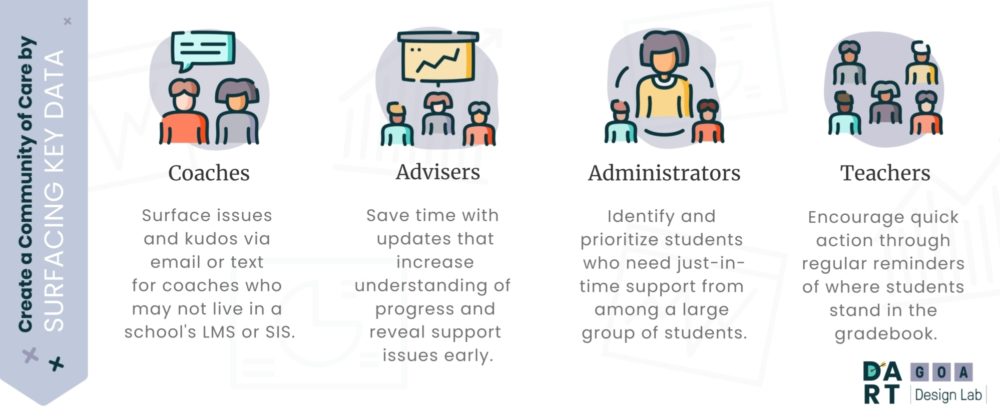How to Use Data to Improve Student Support
I was a sophomore in high school, frizzy-haired and fresh out of braces, when I decided to take a risk in my American history presentation. Donning an orange bucket hat, argyle sweater vest, and high-waisted khakis, I discussed 1960’s music from the perspective of a hippie’s annoyed grandfather.
I don’t remember my grade on that presentation, or in that class as a whole, but I do remember Mr. O’Brien leaning against the windowsill at the back of the classroom, laughing at my jokes. Over my four years in high school, a collection of these moments added up, totaling in an overall positive experience. I did well and remember it fondly, which I think is what all educators hope for their students.
At GOA, we’re launching a tool to make time for more of these moments at schools. DART, our new Data Action Reporting Tool, connects to your school’s Learning Management System (LMS) to collect and organize evidence of student performance, creating email reports that can be sent to various student support audiences. These reports allow educators to act sooner on clearer data, increasing efficiency so that educators can spend less time digging through Canvas and more time connecting with students.
Data Action Reporting Tool (DART)
DART is a student support tool GOA created and has been using in its Student Program. Our online courses are small, relationships-based, and conducted in Canvas LMS. We heard from teachers and member school site directors that finding relevant data and acting on it was time-consuming. They were spending more time looking for data than they were acting on it. They asked if there was a way to generate an organized overview of the most important data, data that could help them make decisions about how best to communicate with and support students.
The GOA team uses DART to measure student participation in Canvas, count missing assignments, and collect grade averages to generate weekly lists of students who deserve kudos or might need support. Depending on the content of each report, teachers and site directors schedule meetings with students, initiate interventions, and engage with GOA’s student support team.
DART grounds student support conversations in data and hastens educator awareness of student performance. In other words, educators are more informed and sooner, so that their support conversations become more proactive than punitive. DART is a tool that interprets grades and trends, but its purpose is to create efficiencies so that the emphasis remains on relationships that improve the educational experience for everyone.

We’ve piloted DART with five GOA member schools, each with their own use cases. At Lake Highland Preparatory School in Orlando, Florida, they’re delivering DART reports to their coaches, whose student athletes must perform to a certain level academically before they can participate in athletic events. The coaches don’t have access to the school’s Student Information System (SIS), so DART collects data from Lake Highland’s Canvas domain and delivers it to coaches so that they can guarantee eligibility for the students on their rosters.
At Gilman School in Baltimore, Maryland, DART reports offer a reliable cadence of information delivery to advisers. As Gilman’s Director of Technology, Tye Campbell said, “we want advisers to be regularly informed about their students.”
Leaders at The Blake School in Minneapolis, Minnesota, recognize that any expansion of programs requires increased efficiencies. They’re delivering DART reports to their division directors and, like Kent Denver School in Englewood, Colorado, to their deans. These administrators oversee large groups of students, so knowing which students may need support and which deserve kudos is crucial to ensuring students have the support they need.
Then there are teachers. Beyond reminding teachers of the evidence in their gradebooks, DART exposes inconsistencies and sometimes inequities in grading. Our Lake Highland partners plan to use DART as a training tool on effectively using online learning tools when they expand their online course offerings. Every school considering the role of online learning after the COVID-19 pandemic should be investigating tools like DART that organize and bring transparency to online systems and structures.
Whatever the audience, whatever the use case, efficiently surfacing actionable data improves the educational experience, for both educators and students. It keeps the focus on the human part of education, the moments we remember and that have lasting impact on student lives.
In my case, those relationships may have given me unwarranted confidence in my comedic timing, but they also taught me that educational risks could be worth it, and if I failed, I had people around me who were equipped to support me. It’s a lesson I remain grateful for to this day.
To learn more about how GOA uses data to support its mission, read these articles:
- Relationships are the Foundation of Online Learning Design. Here’s How We Know.
- What Do Students Expect From Online Learning? We Asked Them.
- Data-Driven, Goal-Oriented: Collecting Student Feedback that Matters
Want to bring DART to your school? Inquire about becoming an early adopter. The GOA Design Lab offers products and services that empower school leaders to guide their communities into the future. Learn more about our work.

